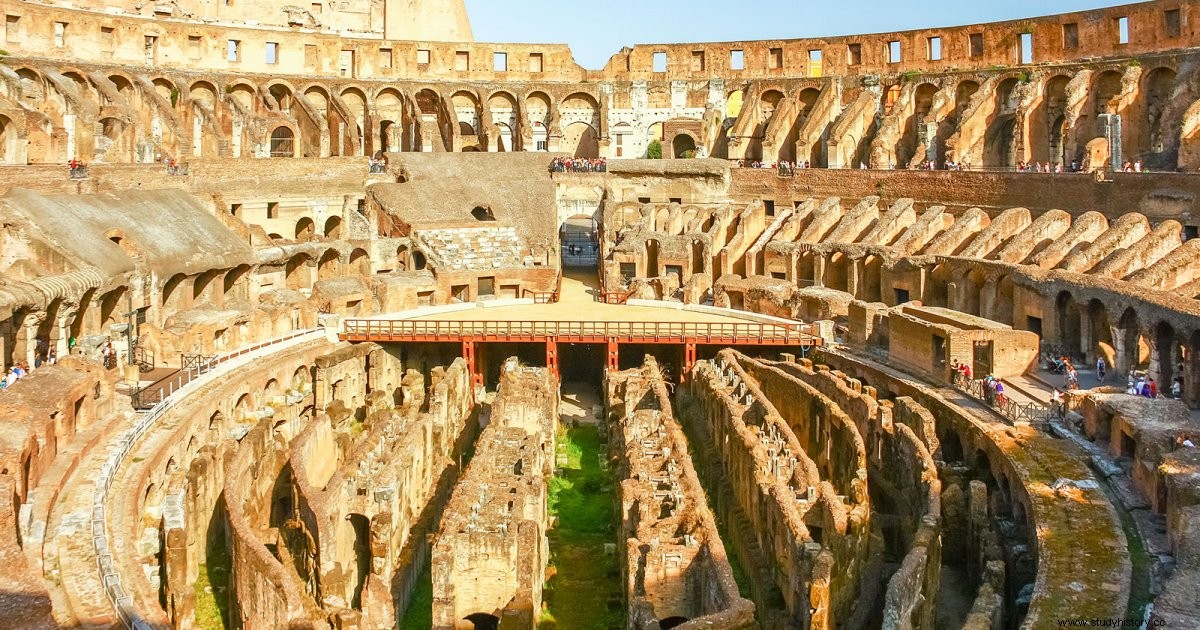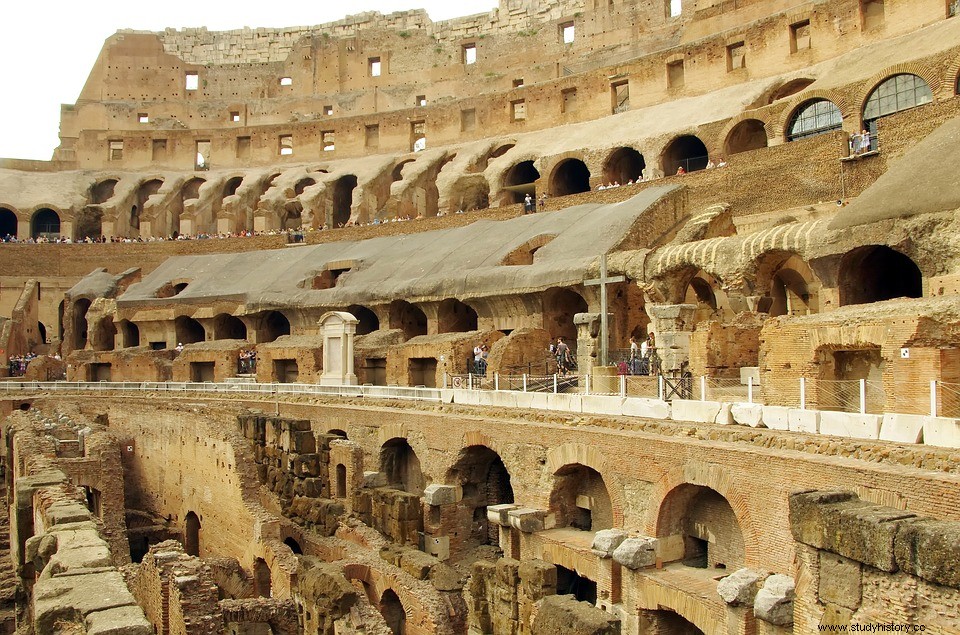
Colosseum:internal view
The following text was sent to Pills of History by Professor Pier Luigi Guiducci , teacher of Church History at the Pontifical Lateran University.
The article, written by Doctor Carlo Mafera , concerns a recent discovery that has affected the Colosseum and the related study of a cross and two Roman letters.
In inviting you to read, I thank Professor Guiducci for his authoritative contribution.

Interior of the Colosseum
In an intermediate gallery of the Colosseum, which leads to the third level (on the north side), the prof. Pier Luigi Guiducci (Lateran University), observing a patch of plaster, studied a cross and two large letters: a “T” and an “S” .
After the second letter, the line continues curving down to the left in the direction of the "T".
All this seems to express:relief, prominence, underlining.
What is the meaning of the two large letters?
Since the Romans did not write names (eg Tarcisius) indicating only the first and last letter, the two letters give the idea of wanting to express rather an exclamation.
To enhance something.
A possible confirmation of this could be obtained from the line that connects the two letters to each other.
At this point the question is:what term can be contained between the initial letter "T" and the final letter "S"?
For prof. Guiducci an indication could derive from the exclamations used during the venationes .
Reviewing various examples, we realize that there is a keyword starting with "T" and ending with "S": taurus (bull).
If one favors this reading, the two letters then express, in a synthetic way, a very clear exclamation:" taurus! taurus! taurus! ".
It was the cry of the spectators who were waiting for the entry of a bull.
The animals in the Colosseum 'games' were used from 80 AD. to 523. However, since the fourth century AD. the use of collecting materials from the amphitheater began.
In 523 the building was now without the colonnade, with serious damage to the auditorium, the entrances and other points.
The venationes were reduced.
Currently, people are inclined to think that the use of bulls in the 'games' of the Colosseum did not go beyond the third century.
The reference to the bull then takes on further significance if we consider the fact that Mithraism (mystery religion) and the cult of the goddess Cybele were widespread in Rome.
Close to the large letter "P", and in any case between this letter and the "S", there is a drawing of a Latin cross.
It is a crux simple type; has the same red color of the "P" and "S"; it is close to the "P" but is visibly detached from the latter ; is placed along the line that connects the "P" and "S"; the size of the crux they are very small compared to the already cit . letters; the stroke is not faint; expresses a precise intentionality; the base of the crux it is ruined, you seem to see a 'hill'; next to the crux there are modern writings.
A new quaestio arises :what interpretation to give to a crux that cannot be found in an area close to the arena?
Why design a signum fidei just in a marginal, dimly lit room, in a passage that led to urinals?
With reference to the signum fidei cit. you can write down some questions.
1] The crux it was painted to favor the oratio fidelium ?
The hypothesis seems weak. The oratio it will be favored above all from the Middle Ages onwards.
2] The crux attests to a devotio Crucis ?
It doesn't seem like it.
This was favored with the pious exercise of the Via Crucis (1750).
3] The crux it is a memory to celebrate cults?
This hypothesis is not convincing:the design is identifiable but is not positioned according to the classic criteria of 'memory', it is not in an adequate environment.
4] The design was an isolated initiative of someone who, in a moment of inactivity, wanted to 'add' a signum to a wall religious?
It is a thesis that does not convince.
No believer drew a cross 'for fun'. For 'pastime'.
The crux seems to be an 'answer' added to those who previously drew the two letters "T" and "S".
The desire then to bring the attention of those who passed through that environment back to a religious symbol seems to refer in a subdued way to the realism of the cross (suffering) and its redemptive meaning (Christ saves).
Finally, mention should be made of the crosses - dated 3rd century - identified in two catacombs and in the hypogeum of the Aurelii and the fact that with the beginning of the Constantinian period (4th century) it is no longer necessary to take precautions to draw crosses.
In this context, for prof. Guiducci, a hypothesis does not seem weak.
At a time when many people died in the arena (including anonymous Christians), some followers of Jesus of Nazareth wanted to emphasize pietas and reliance on the Lord.
To the exaltation of vigor, strength, blood, dominance (ref. To taurus ), An anonymous Christian contrasted with pietas and faith.
Drawing a small cross ( Article written by Doctor Carlo Mafera and sent by Professor Pier Luigi Guiducci ).
